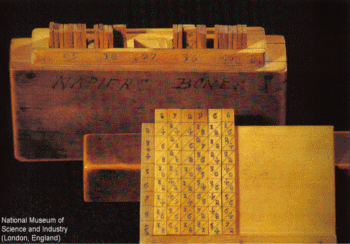 SKC Films Library SKC Films Library |
| SKC Films Library >> Science >> Mathematics >> Instruments and Machines |
| Napier's Bones These numbered rods were created by Scottish mathematician John Napier to aid multiplication and division of long numbers. Each face of the rod is marked at the top with one of the ten counting digits and below are listed each of its multiples. The rods are laid alongside each other so that the multi-digit number to be multiplied appears in the topmost row. Any multiple of this number can then be read off right to left along the row of the required multiple. The trick of the bones is in the layout of the numbers. The units and tens are separated by a diagonal, and in a given row the tens digit from a column on the right shares a parallelogram with the units digit in the column immediately left. By reading from right to left and mentally adding pairs of numbers in each parallelogram on the same row, answers can be read off directly and written down. In the picture above, the number to be multiplied is 272,968. To multiply that number by 4, run down the left-hand index to "4" and read that row from right to left adding number pairs, resulting in the answer 1,091,872. Division of numbers was assisted by using the bones to perform trial multiplications. Separate sets of bones were devised to calculate square and cube roots. Napier's ingenious device got its now-popular name from the fact that more expensive versions of it were made from bone, horn or ivory. PRINT SOURCE SEE ALSO |
| SKC Films Library
>> Science >> Mathematics >> Instruments and Machines This page was last updated on 06/23/2017. |
